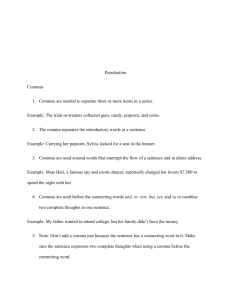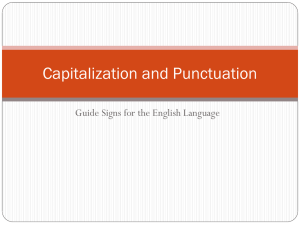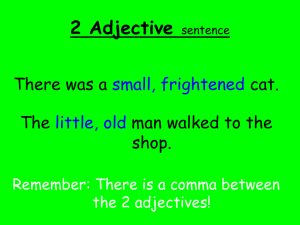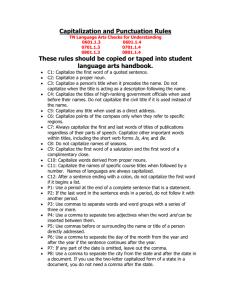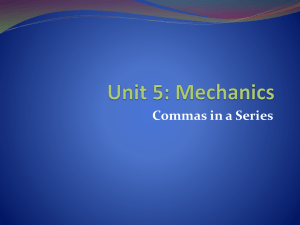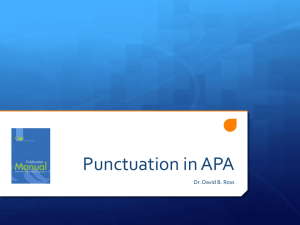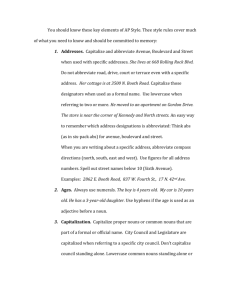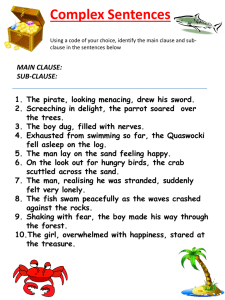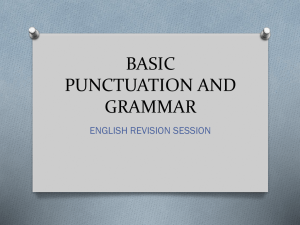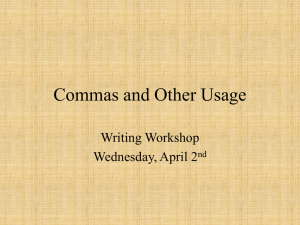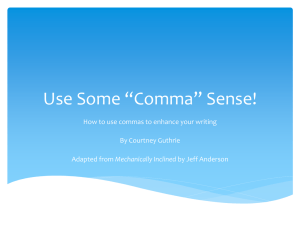comma - Saint John the Beloved School
advertisement
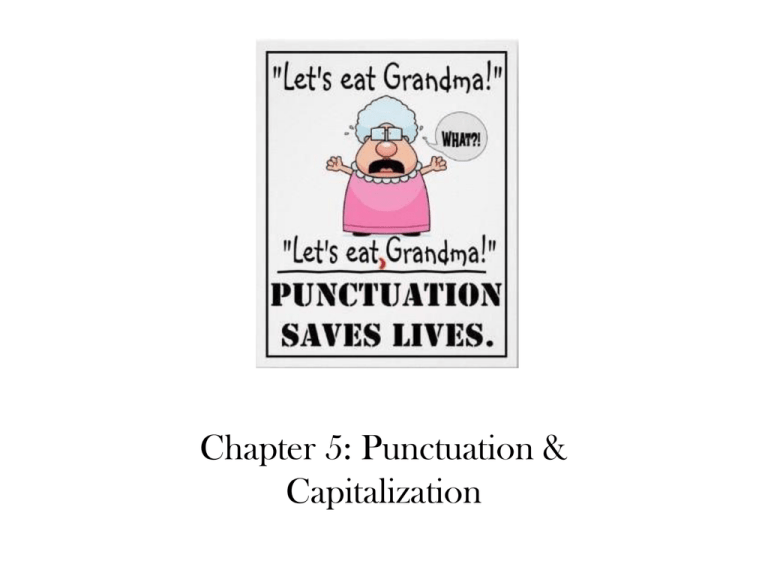
Chapter 5: Punctuation & Capitalization Interjection s A word or group of words that express feeling or represents a sound Wow! That is delicious! Boom! The entire stack of books toppled over. Oh, I didn’t realize she was busy on that day. Use an exclamation point after an interjection expressing a strong feeling Hey! You’re stepping on my foot! Goodness! We have three tests tomorrow! Use a comma after an interjection that expresses a milder feeling Hey, what are you doing tomorrow? Well, I wanted to go and get lunch. Okay, I will call you when I leave school. Sentences & Interjections Every sentence begins with a capital letter. A declarative sentence makes a statement and ends with a period “I read a book.” An interrogative sentence asks a questions and ends with a question mark. “Do you have an SSR book?” An imperative sentence expresses a command and ends in a period. “Hand me that pencil.” An exclamatory sentence indicates strong feeling and ends in an exclamation point. “Look! It’s a shooting star!” Proper Nouns & Proper Adjectives We know a proper noun names a particular person, place, or thing and that a proper noun always begins with a capital letter. Do not capitalize minor words like of, and, or, the. 1) Capitalize cities, states, countries & continents. Chicago, Texas, North America, the United States of America 2) Capitalize bodies of water and geographical features Ohio River, Gulf of Mexico, the Rocky Mountains 3) Capitalize the names of areas. Do not capitalize directions. the Southwest, the Middle East, Central Asia We traveled south along the coast, then east 4) Capitalize streets and highways Interstate 95, Wall Street, Avenue of the Stars 5) Capitalize buildings bridges & monuments Statue of Liberty, the World Trade Center, Delaware Memorial Bridge A proper adjective is formed from a proper noun Mexican art, North American birds, Parisian fashion, Jeffersonian democracy Titles, Organizations, Dates & Subjects 1) Specific titles for people but NOT if they’re used alone as common nouns President Obama The president of the committee Father Etim a father and son vacation Uncle Jim My aunt and uncle are visiting. 2) Capitalize organizations, institutions and businesses St. John the Beloved School, University of Delaware, Astra Zeneca 3) Capitalize languages & specific school subjects, but NOT general school subjects Our Spanish class is so much fun. I am taking French in high school. Are you taking Psychology 101? We have social studies after English. My favorite subjects are math and science. Titles, Organizations, Dates & Subjects 4) Capitalize historical events, periods of time, and documents Boston Tea Party, the Gettysburg Address, the Civil War, Declaration of Independence 5) Capitalize days, months, and holidays but NOT seasons September Saturday The fall is the best season. The summer months are too hot. Uses for Commas 1. Commas can be used in a series (three or more related words) Words: He collected rocks, movies, posters, and CDs. Phrases: People often take pictures during sports events, on vacations, and during special occasions. Clauses: Stacy wrote the rough draft, I revised it, and Sharon typed it. Uses for Commas 2) Use a comma between two or more adjectives that come before a noun The big, black, fat cat sat on the porch all day long. 3) Do not use a comma with two or more adjective if they’re used to express a single idea. Try reading the adjectives with and or reversing their order, if it sounds awkward do not use a comma. Leon uses an expensive Japanese camera. Awkward: Leon uses and expensive and Japanese camera. Awkward: Leon uses a Japanese expensive camera. Uses for Commas 4) Use a comma to separate two independent clauses used in the same sentence. ALSO, use a comma if there is a dependent clause, followed by an independent clause. Since he was talking, he did not hear the directions. Because we are going to Gettysburg, we will be able to dress casually on Friday. We wanted a picture of the sunrise, but it rained that day. 1) Commas: Introductory Phrases Use commas after words, phrases, and clauses that come at the beginning of a sentence. Oh I need to remember to study for math. In the beginning the movie was boring. Arriving late Mary tried to walk in quietly. During the long meeting he fell asleep. After the session ended I spoke to Hal. While I waited I made some phone calls. Commas: Interrupters 2) Interrupters are words that break up a sentence and add emphasis. Use commas to separate them from the rest of the sentence. • If a phrase is between two commas, the sentence can be read without it. You know of course the purpose of this meeting. Come into my office Janice for a few minutes. We will meet again next week by the way. Commas: Nouns of Direct Address 3) A noun of direct address is the name of the person spoken to directly. It can come anywhere in the sentence. Separate it from the rest of the sentence with commas. Come into my office Mary for a minute. You know Lauren this will help in the long run. Marie why did you call me last night? Staple these papers together James. Commas: appositives 4) An appositive adds information about the noun that directly preceded it. Use commas to separate an appositive only if it is not necessary to identify the noun. The president Harold White will present the award. The stray cat starving and sick needs a good home. If it is necessary to understand the sentence, do not use commas. The documentary Space Explorer won the Academy Award. My friend Patrick loves that movie. Dates, Letters & Addresses 1) With dates, use commas to separate month and day from the year AND year & date from the rest of the sentence. • July 4, 1776, is the day our nation was born. 2) Between city & state • Philadelphia, Pennsylvania Dates, Letters & Addresses 3) Between street & city and city & state • Send the item to 15 Mulberry Drive, Wilmington, Delaware 19808. 4) In a letter, after greeting and closing: • Dear Amy, • Sincerely, • With Love, Quotation Marks • Direct Quotation: a speaker’s exact words • Indicated by quotation marks Begin a direct quote with a capital letter. Use a comma to separate the quotation from the rest of the sentence. My mother always says, “Tell the truth the first time!” Quotation Marks 2) Punctuation usually goes inside quotes. -Periods and commas are always inside -Question marks and exclamation points go inside when it is related to the actual quote. -If they are not a part of the quote, they will go outside “Where is Spain?” asked the teacher. Ralph said, “I think we learned this last year.” Did Denise say, “I don’t know”? Quotation Marks 3) A divided quotation is when one quote is separated into two places Only the first letter in the quote is capitalized, they first letter in the second part is not: “Go to sleep early,” said Michelle, “and you will not feel so tired in school.” If it is two separate sentences, both will start with a capital letter. “You must go to sleep earlier,” she said, “It will be better for your health.” Quotation Marks 4) An indirect quote tells what someone said without using exact words (paraphrasing) Do not use quotations for these. Kim said that Tasmania is off the coast of Africa. Ralph asked to look at the map. Examples 1. Mr. Romero asked is Australia a country? 2. Yes replied Lauren. 3. Mr. Romero asked is Australia a continent? 4. Howard answered I’m not sure. 5. Please reply said Mr. Romero if you know the answer. 6. Anna said that Australia has had an unusual history. 7. That’s right said Mr. Romero. It is a country and a continent. 8. Did Mr. Romero say tell me more about Australia? Titles of Short Works Quotation marks are also used for titles of short works. The first, last, and all important words in the title are capitalized. Short Story: “The Tell-Tale Heart” Poem: “Jabberwocky” Chapter of a Book: “Writing Business Reports” Magazine Article: “How to Improve Your Work” Song: “The Star-Spangled Banner” Examples 9. looking for the kiwi (short story) 10. the extraordinary animals of australia (article) 11. waiting for the boat to take me there (song) 13. in the station (poem) 14. the raising of sheep in australia (chapter in a book) 15. coming of age in the outback (book chapter) 16. australia and tasmania (poem) Titles of Long Works In print, titles of long works are typically in italics. If you are writing by hand, you should underline titles of long works. Book: A Summer to Remember Magazine: Sports Illustrated Newspaper: The New York Times; Denver Post Play: Fiddler on the Roof Movie: The Nightmare Before Christmas TV Series: The American Experience Painting: Sunflowers Musical Works: Symphony No. 5, The Marriage of Figaro Colons: Use a colon… 1. After the greeting in a business letter Dear Sir: To Whom it May Concern: 2. When writing the time 8:40 A.M. Colons : 3. Before a list of items in a sentence In music class we study these composers: Ives, Bach, and Mozart. Bring the following to class: a pen, your notebook, and your textbook. 4. DO NOT use a colon after a verb or a preposition Bring a book, a harmonica, and a notebook to class. The program consists of a solo, a duet, and a trio.
